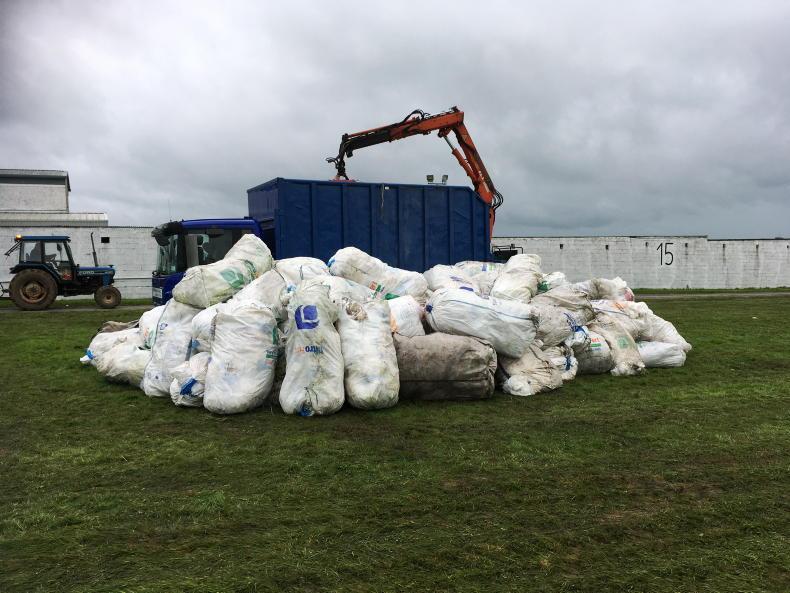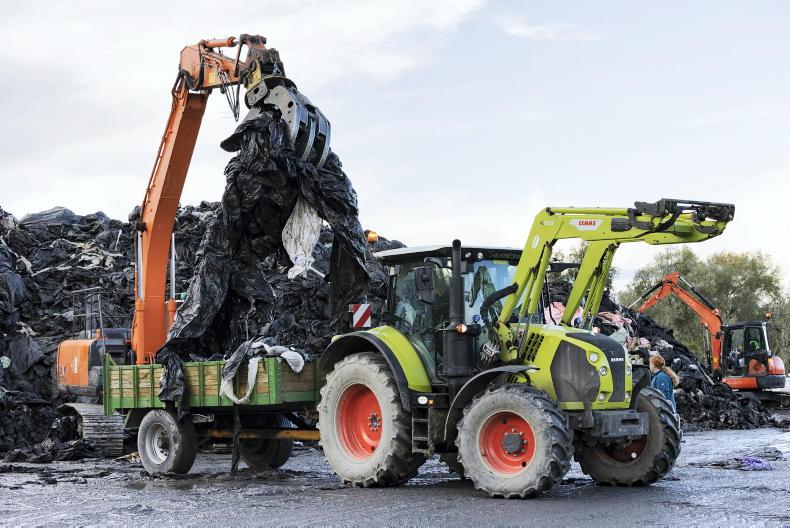Irish farmers are increasingly recycling their fertiliser bags, with the volume recycled doubling over the last five years to the current level of 1,000t per year.
Fertiliser bags were collected at over 200 bring centres in 2022, operated by Farm Plastics Recycling CLG, a sister company of the Irish Farm Films Producers Group (IFFPG), the national farm plastics recycling scheme. Farmers were charged at a rate of €10 for each half-tonne-sized bag filled with fertiliser bag waste delivered to bring-centres, with almost 20,000 bags of waste collected.
The present level of recycling is in line with the current national plastics packaging recycling rate of 34%
The volume of fertiliser bag recycling has more than doubled in the last five years, with an estimated 30-35% recycling rate currently being achieved for this waste stream. The present level of recycling is in line with the current national plastics packaging recycling rate of 34%.
Recent progress can be attributed to a number of factors. They include the relative convenience (the average farmer is six miles from a local bring-centre), cost effectiveness of the bring-centre service, as well as growing environmental awareness among farmers. In addition, Repak, which is the national packaging recycling scheme, is making more funding available for plastic packaging recycling to ensure that a challenging 50% recycling target is met by 2025.
Fertiliser suppliers in Ireland currently meet their obligations through Repak membership. This involves paying fees to Repak for every tonne of packaging placed on the Irish market.
In turn, Repak uses this funding to stimulate recycling by subsidising the collection and recycling of plastic packaging. In the case of fertiliser bag recycling, additional Repak funding has been largely used to further increase awareness of the service among farmers.
Repak, which is the national packaging recycling scheme, is making more funding available for plastic packaging recycling
Key to the success of fertiliser bag recycling is the correct presentation of fertiliser bag plastics at bring-centres. This involves farmers having to segregate the different plastic types into different bags.
As bulk fertiliser bags are comprised of two different plastic types, the outer part of the bag (polypropylene) must be separated from the inside line (polyethylene) before presentation at bring centres.
The small fertiliser bags, which are made of the same plastic as the liners of the bulk fertiliser bags, can be presented mixed together at bring centres.
IFFPG manager Liam Moloney said: “Feedback from recyclers confirms that the quality of presentation of fertiliser bag at bring centres is improving year-on-year and critical to the recycling success of this waste stream.”
All fertiliser bags collected are sent for recycling into a range of new products, including bags, crates and car parts.
In the case of one Irish recycler, IFF Plastics, which is located in west Clare, fertiliser bags are recycled into fence posts, which are sold back to Irish farmers in an excellent example of the circular economy at work.
Feedback from recyclers confirms that the quality of presentation of fertiliser bag at bring centres is improving year-on-year
IFFPG had another exceptionally successful year in 2022 across the range of farm plastic wastes that the scheme manages.
In the case of silage wrap and sheeting waste, which accounts for over 95% of all collections, almost 37,000t of waste was recycled and an 88% recycling rate was achieved (equivalent to plastic from 18m bales), while over 1,100t of netting and twine waste was also collected for recovery.
For further information visit www.farmplastics.ie or telephone 01-408 9966.
Big bags
The following guidelines should be adhered to when handling big bags of fertiliser:
1 Beware of overhead wires, power cables and other hazards.2 Never load, unload or handle big bags on a slope. Always choose a flat piece of ground.3 No one should stand beneath or close to the load when it is being lifted, moved or emptied.4 Before lifting, check that lifting loops are not worn or cut. Forks or hooks being used should be smooth.5 Never allow the loop of the bag to slide along the fork that is lifting it. Keep the fork level at all times. 6 Big bags should never be pulled along the ground or dragged sideways.7 Once lifted, complete the task and do not leave the load hanging in the air. 8 Big bags should not be allowed to swing against handling equipment.9 When cutting the big bag, never stand underneath the bag.10 Never cut the underneath of the bag.11 When emptying, suspend the bag over the spreader and cut an X on the side of the bag, 15cm above the base, with a long-handled knife. Particular care should be taken here. 12 You can partly empty the bag into the spreader by cutting at the appropriate level to let out the required amount of fertiliser.Small bags
1 All bags should be lifted by a minimum of two people.2 To minimise lifting, lift off a trailer at waist height or by drawing along a trailer to the spreader.3 When lifting the bag, adopt a shoulder-wide boxer stance with your feet firmly on the ground, grip firmly, bend your knees, keep your back straight and lift with your thigh muscles. 4 Always keep the bag close to your body and grip it firmly.5 Face in the direction of the spreader and never twist your spine by having your back to the spreader.6 Always have your feet turned in the direction of movement. 7 Put the bag down first, then adjust its position. 8 Training should be undertaken and alternatives should be considered to minimise lifting.
Irish farmers are increasingly recycling their fertiliser bags, with the volume recycled doubling over the last five years to the current level of 1,000t per year.
Fertiliser bags were collected at over 200 bring centres in 2022, operated by Farm Plastics Recycling CLG, a sister company of the Irish Farm Films Producers Group (IFFPG), the national farm plastics recycling scheme. Farmers were charged at a rate of €10 for each half-tonne-sized bag filled with fertiliser bag waste delivered to bring-centres, with almost 20,000 bags of waste collected.
The present level of recycling is in line with the current national plastics packaging recycling rate of 34%
The volume of fertiliser bag recycling has more than doubled in the last five years, with an estimated 30-35% recycling rate currently being achieved for this waste stream. The present level of recycling is in line with the current national plastics packaging recycling rate of 34%.
Recent progress can be attributed to a number of factors. They include the relative convenience (the average farmer is six miles from a local bring-centre), cost effectiveness of the bring-centre service, as well as growing environmental awareness among farmers. In addition, Repak, which is the national packaging recycling scheme, is making more funding available for plastic packaging recycling to ensure that a challenging 50% recycling target is met by 2025.
Fertiliser suppliers in Ireland currently meet their obligations through Repak membership. This involves paying fees to Repak for every tonne of packaging placed on the Irish market.
In turn, Repak uses this funding to stimulate recycling by subsidising the collection and recycling of plastic packaging. In the case of fertiliser bag recycling, additional Repak funding has been largely used to further increase awareness of the service among farmers.
Repak, which is the national packaging recycling scheme, is making more funding available for plastic packaging recycling
Key to the success of fertiliser bag recycling is the correct presentation of fertiliser bag plastics at bring-centres. This involves farmers having to segregate the different plastic types into different bags.
As bulk fertiliser bags are comprised of two different plastic types, the outer part of the bag (polypropylene) must be separated from the inside line (polyethylene) before presentation at bring centres.
The small fertiliser bags, which are made of the same plastic as the liners of the bulk fertiliser bags, can be presented mixed together at bring centres.
IFFPG manager Liam Moloney said: “Feedback from recyclers confirms that the quality of presentation of fertiliser bag at bring centres is improving year-on-year and critical to the recycling success of this waste stream.”
All fertiliser bags collected are sent for recycling into a range of new products, including bags, crates and car parts.
In the case of one Irish recycler, IFF Plastics, which is located in west Clare, fertiliser bags are recycled into fence posts, which are sold back to Irish farmers in an excellent example of the circular economy at work.
Feedback from recyclers confirms that the quality of presentation of fertiliser bag at bring centres is improving year-on-year
IFFPG had another exceptionally successful year in 2022 across the range of farm plastic wastes that the scheme manages.
In the case of silage wrap and sheeting waste, which accounts for over 95% of all collections, almost 37,000t of waste was recycled and an 88% recycling rate was achieved (equivalent to plastic from 18m bales), while over 1,100t of netting and twine waste was also collected for recovery.
For further information visit www.farmplastics.ie or telephone 01-408 9966.
Big bags
The following guidelines should be adhered to when handling big bags of fertiliser:
1 Beware of overhead wires, power cables and other hazards.2 Never load, unload or handle big bags on a slope. Always choose a flat piece of ground.3 No one should stand beneath or close to the load when it is being lifted, moved or emptied.4 Before lifting, check that lifting loops are not worn or cut. Forks or hooks being used should be smooth.5 Never allow the loop of the bag to slide along the fork that is lifting it. Keep the fork level at all times. 6 Big bags should never be pulled along the ground or dragged sideways.7 Once lifted, complete the task and do not leave the load hanging in the air. 8 Big bags should not be allowed to swing against handling equipment.9 When cutting the big bag, never stand underneath the bag.10 Never cut the underneath of the bag.11 When emptying, suspend the bag over the spreader and cut an X on the side of the bag, 15cm above the base, with a long-handled knife. Particular care should be taken here. 12 You can partly empty the bag into the spreader by cutting at the appropriate level to let out the required amount of fertiliser.Small bags
1 All bags should be lifted by a minimum of two people.2 To minimise lifting, lift off a trailer at waist height or by drawing along a trailer to the spreader.3 When lifting the bag, adopt a shoulder-wide boxer stance with your feet firmly on the ground, grip firmly, bend your knees, keep your back straight and lift with your thigh muscles. 4 Always keep the bag close to your body and grip it firmly.5 Face in the direction of the spreader and never twist your spine by having your back to the spreader.6 Always have your feet turned in the direction of movement. 7 Put the bag down first, then adjust its position. 8 Training should be undertaken and alternatives should be considered to minimise lifting. 









SHARING OPTIONS